fuel cap TOYOTA TUNDRA 2017 2.G Owners Manual
[x] Cancel search | Manufacturer: TOYOTA, Model Year: 2017, Model line: TUNDRA, Model: TOYOTA TUNDRA 2017 2.GPages: 588, PDF Size: 10.76 MB
Page 3 of 588
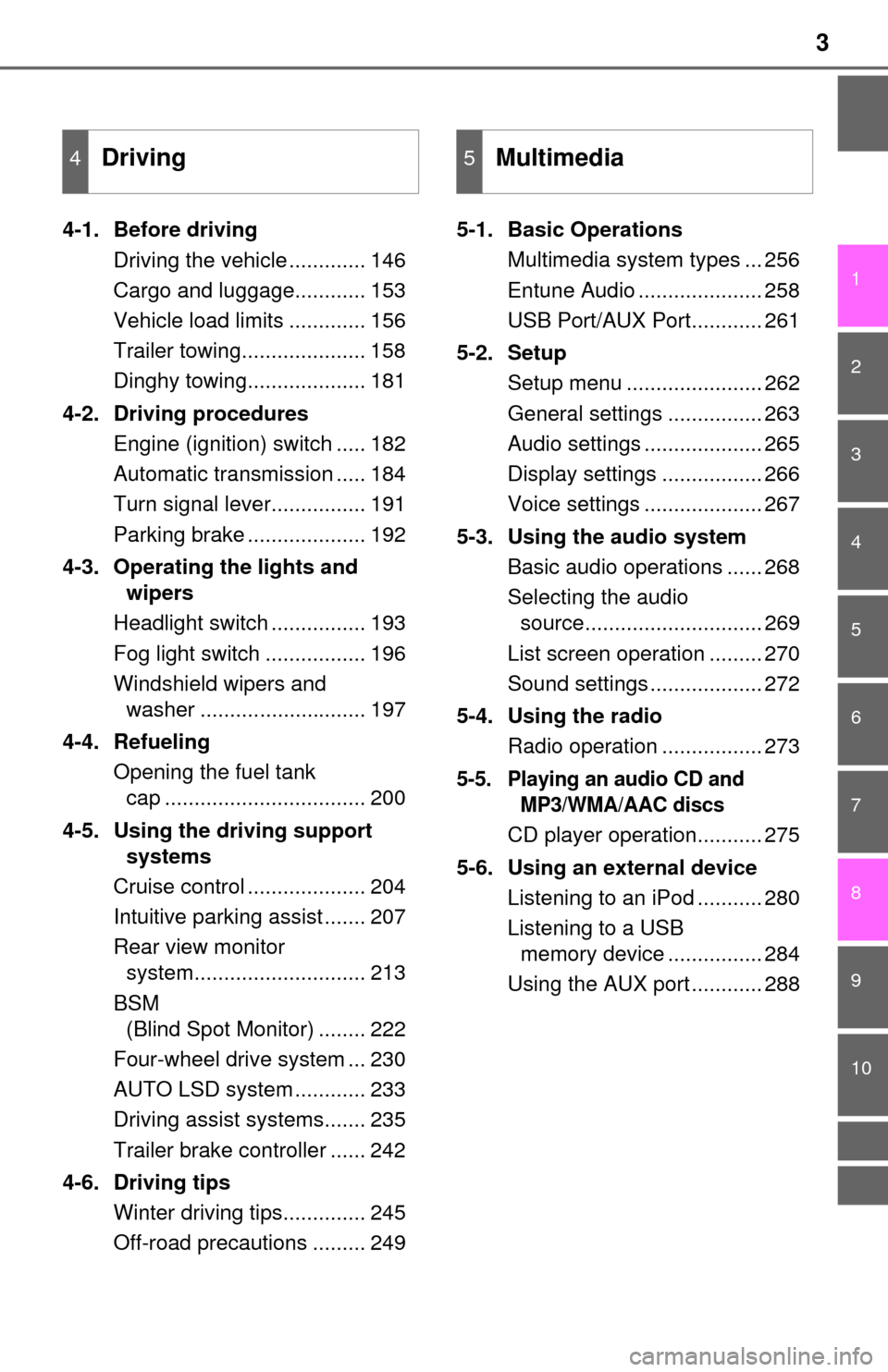
3
1
9 8
7 5 4
3
2
10
6
4-1. Before drivingDriving the vehicle ............. 146
Cargo and luggage............ 153
Vehicle load limits ............. 156
Trailer towing..................... 158
Dinghy towing.................... 181
4-2. Driving procedures Engine (ignition) switch ..... 182
Automatic transmission ..... 184
Turn signal lever................ 191
Parking brake .................... 192
4-3. Operating the lights and wipers
Headlight switch ................ 193
Fog light switch ................. 196
Windshield wipers and washer ............................ 197
4-4. Refueling Opening the fuel tank cap .................................. 200
4-5. Using the driving support systems
Cruise control .................... 204
Intuitive parking assist ....... 207
Rear view monitor system............................. 213
BSM (Blind Spot Monitor) ........ 222
Four-wheel drive system ... 230
AUTO LSD system ............ 233
Driving assist systems....... 235
Trailer brake controller ...... 242
4-6. Driving tips Winter driving tips.............. 245
Off-road precautions ......... 249 5-1. Basic Operations
Multimedia system types ... 256
Entune Audio ..................... 258
USB Port/AUX Port............ 261
5-2. Setup Setup menu ....................... 262
General settings ................ 263
Audio settings .................... 265
Display settings ................. 266
Voice settings .................... 267
5-3. Using the audio system Basic audio operations ...... 268
Selecting the audio source.............................. 269
List screen operation ......... 270
Sound settings ................... 272
5-4. Using the radio Radio operation ................. 273
5-5. Playing an audio CD and MP3/WMA/AAC discs
CD player operation........... 275
5-6. Using an external device Listening to an iPod ........... 280
Listening to a USB memory device ................ 284
Using the AUX port ............ 288
4Driving5Multimedia
Page 15 of 588
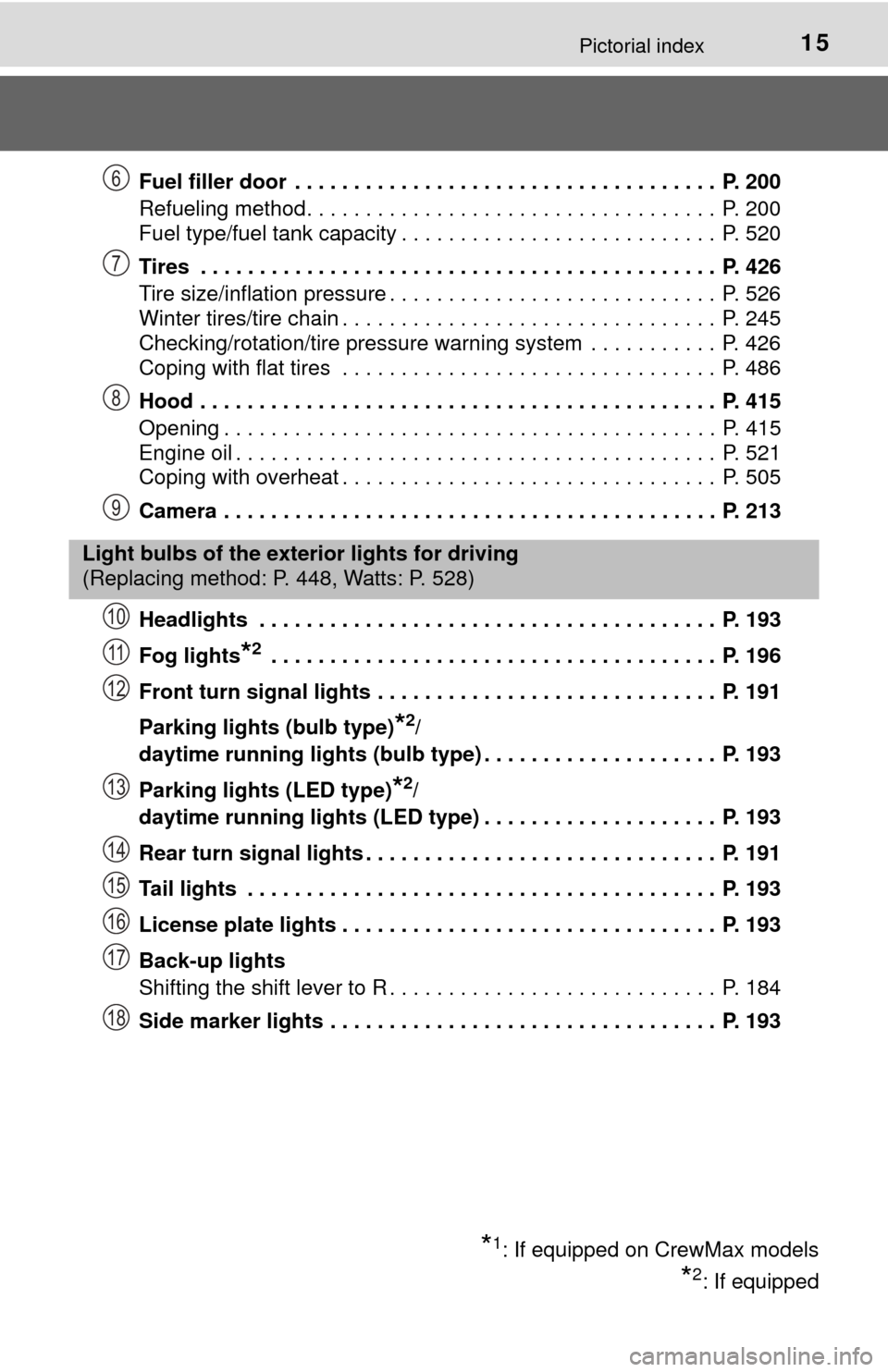
15Pictorial index
Fuel filler door . . . . . . . . . . . . . . . . . . . . . . . . . . . . . . . . . . . . P. 200
Refueling method . . . . . . . . . . . . . . . . . . . . . . . . . . . . . . . . . . . P. 200
Fuel type/fuel tank capacity . . . . . . . . . . . . . . . . . . . . . . . . . . . P. 520
Tires . . . . . . . . . . . . . . . . . . . . . . . . . . . . . . . . . . . . . . . . . . . . P. 426
Tire size/inflation pressure . . . . . . . . . . . . . . . . . . . . . . . . . . . . P. 526
Winter tires/tire chain . . . . . . . . . . . . . . . . . . . . . . . . . . . . . . . . P. 245
Checking/rotation/tire pressure warning system . . . . . . . . . . . P. 426
Coping with flat tires . . . . . . . . . . . . . . . . . . . . . . . . . . . . . . . . P. 486
Hood . . . . . . . . . . . . . . . . . . . . . . . . . . . . . . . . . . . . . . . . . . . . P. 415
Opening . . . . . . . . . . . . . . . . . . . . . . . . . . . . . . . . . . . . . . . . . . P. 415
Engine oil . . . . . . . . . . . . . . . . . . . . . . . . . . . . . . . . . . . . . . . . . P. 521
Coping with overheat . . . . . . . . . . . . . . . . . . . . . . . . . . . . . . . . P. 505
Camera . . . . . . . . . . . . . . . . . . . . . . . . . . . . . . . . . . . . . . . . . . P. 213
Headlights . . . . . . . . . . . . . . . . . . . . . . . . . . . . . . . . . . . . . . . P. 193
Fog lights
*2 . . . . . . . . . . . . . . . . . . . . . . . . . . . . . . . . . . . . . . P. 196
Front turn signal lights . . . . . . . . . . . . . . . . . . . . . . . . . . . . . P. 191
Parking lights (bulb type)
*2/
daytime running lights (bulb type) . . . . . . . . . . . . . . . . . . . . P. 193
Parking lights (LED type)
*2/
daytime running lights (LED type) . . . . . . . . . . . . . . . . . . . . P. 193
Rear turn signal lights . . . . . . . . . . . . . . . . . . . . . . . . . . . . . . P. 191
Tail lights . . . . . . . . . . . . . . . . . . . . . . . . . . . . . . . . . . . . . . . . P. 193
License plate lights . . . . . . . . . . . . . . . . . . . . . . . . . . . . . . . . P. 193
Back-up lights
Shifting the shift lever to R . . . . . . . . . . . . . . . . . . . . . . . . . . . . P. 184
Side marker lights . . . . . . . . . . . . . . . . . . . . . . . . . . . . . . . . . P. 193
6
7
8
9
Light bulbs of the exterior lights for driving
(Replacing method: P. 448, Watts: P. 528)
*1: If equipped on CrewMax models
*2: If equipped
10
11
12
13
14
15
16
17
18
Page 145 of 588

145
4Driving
4-1. Before drivingDriving the vehicle ............. 146
Cargo and luggage ........... 153
Vehicle load limits ............. 156
Trailer towing..................... 158
Dinghy towing ................... 181
4-2. Driving procedures Engine (ignition) switch ..... 182
Automatic transmission ..... 184
Turn signal lever................ 191
Parking brake .................... 192
4-3. Operating the lights and wipers
Headlight switch ................ 193
Fog light switch ................. 196
Windshield wipers and washer ............................ 197 4-4. Refueling
Opening the fuel tank cap .................................. 200
4-5. Using the driving support systems
Cruise control .................... 204
Intuitive parking assist....... 207
Rear view monitor system ............................ 213
BSM (Blind Spot Monitor) ........ 222
Four-wheel drive system ... 230
AUTO LSD system............ 233
Driving assist systems ...... 235
Trailer brake controller ...... 242
4-6. Driving tips Winter driving tips ............. 245
Off-road precautions ......... 249
Page 200 of 588

2004-4. Refueling
Opening the fuel tank cap
●Turn the engine switch to the “LOC K” position and ensure that all
the doors and windows are closed.
● Confirm the type of fuel. ( →P. 520)
Open the fuel filler door.
Turn the fuel tank cap slowly
open, and hang the fuel tank
cap on the back of the fuel filler
door.
Perform the following steps to open the fuel tank cap:
Before refueling the vehicle
Opening the fuel tank cap
1
2
Page 201 of 588

2014-4. Refueling
4
Driving
After refueling, turn the fuel tank
cap until you hear a click. Once
the cap is released, it will turn
slightly in the opposite direction.
■Fuel types
(
→P. 520)
■ E85 Fueling Stations (Flex-fuel vehicles)
E85 fueling stations and fuel pumps can be identified by the indication “E85
85% Ethanol”. For more information about fueling stations, please refer to the
U.S. Department of Energy Web site.
http://www.afdc.energy.gov/afdc/locator/stations/
■ Refueling (Flex-fuel vehicles)
Observe the following precautions when switching fuels, in order to maintain
starting and driving performance.
●Do not change fuels when the fuel level is 1/4 or less.
● Always add at least 2.6 gal. (10 L) of fuel.
● After filling up with fuel, warm up the engine or drive the vehicle for at least 5
minutes or 7 miles (11 km).
● Do not accelerate rapidly immediately after refueling.
■ Fuel tank opening for unleaded gasoline
To help prevent incorrect fueling, y our vehicle has a fuel tank opening that
only accommodates the special nozzle on unleaded fuel pumps.
Closing the fuel tank cap
Page 202 of 588
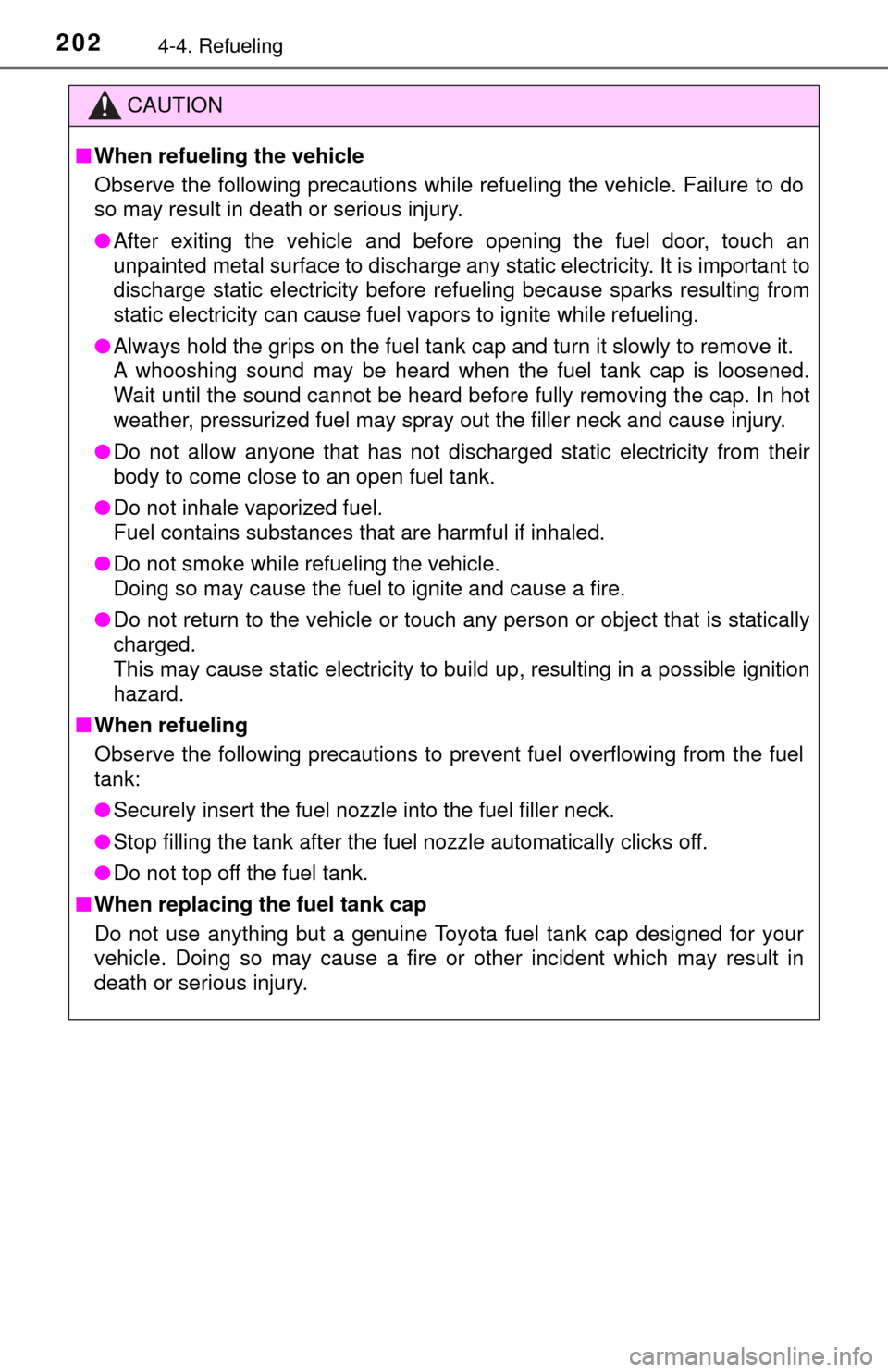
2024-4. Refueling
CAUTION
■When refueling the vehicle
Observe the following precautions while refueling the vehicle. Failure to do
so may result in death or serious injury.
● After exiting the vehicle and before opening the fuel door, touch an
unpainted metal surface to discharge any static electricity. It is important to
discharge static electricity before refueling because sparks resulting from
static electricity can cause fuel vapors to ignite while refueling.
● Always hold the grips on the fuel tank cap and turn it slowly to remove it.
A whooshing sound may be heard when the fuel tank cap is loosened.
Wait until the sound cannot be heard before fully removing the cap. In hot
weather, pressurized fuel may spray out the filler neck and cause injury.
● Do not allow anyone that has not discharged static electricity from their
body to come close to an open fuel tank.
● Do not inhale vaporized fuel.
Fuel contains substances that are harmful if inhaled.
● Do not smoke while refueling the vehicle.
Doing so may cause the fuel to ignite and cause a fire.
● Do not return to the vehicle or touch any person or object that is statically
charged.
This may cause static electricity to build up, resulting in a possible ignition
hazard.
■ When refueling
Observe the following precautions to prevent fuel overflowing from the fuel
tank:
● Securely insert the fuel nozzle into the fuel filler neck.
● Stop filling the tank after the fuel nozzle automatically clicks off.
● Do not top off the fuel tank.
■ When replacing the fuel tank cap
Do not use anything but a genuine Toyota fuel tank cap designed for your
vehicle. Doing so may cause a fire or other incident which may result in
death or serious injury.
Page 412 of 588
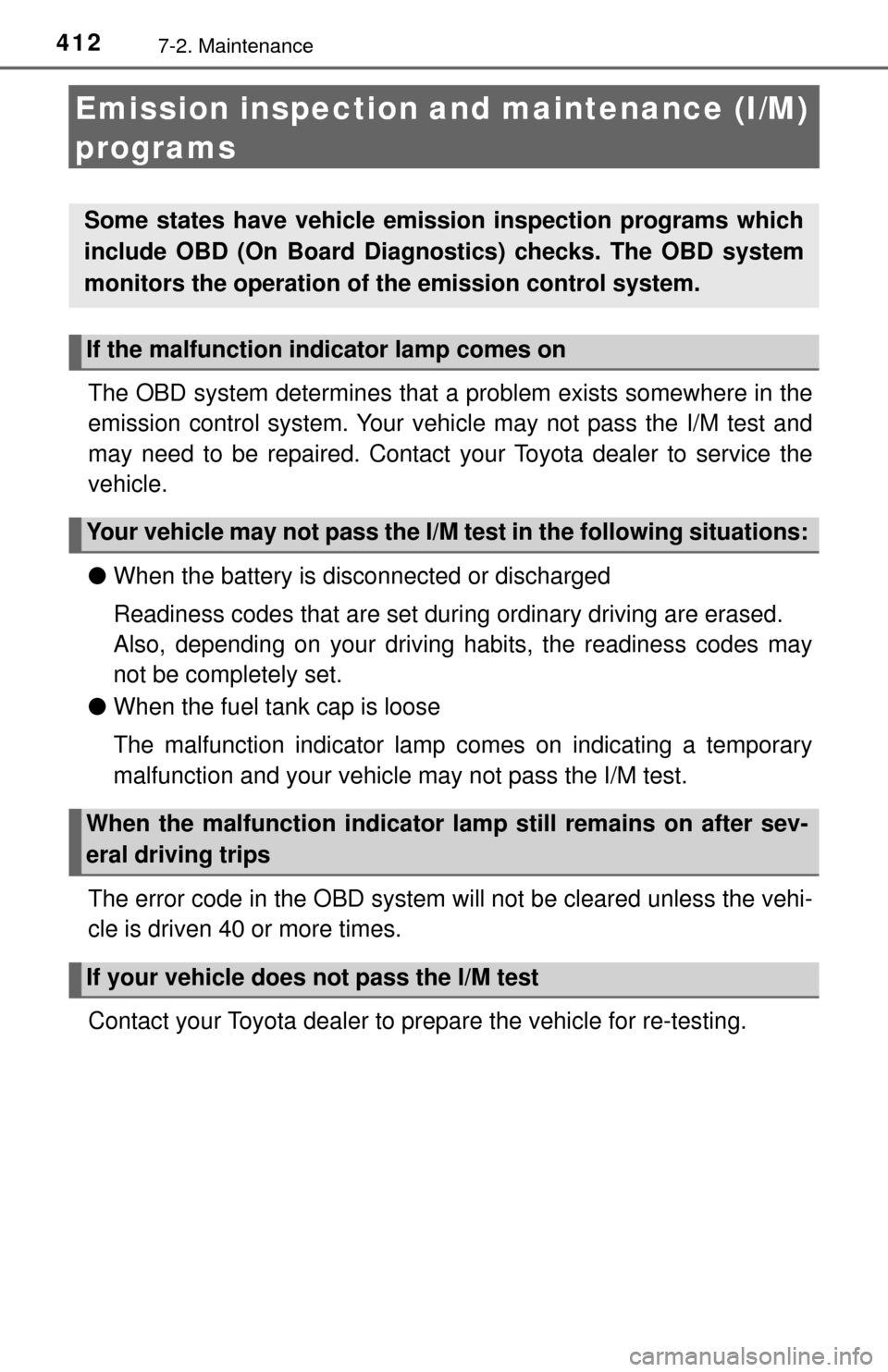
4127-2. Maintenance
Emission inspection and maintenance (I/M)
programs
The OBD system determin es that a problem exists somewhere in the
emission control system. Your vehi cle may not pass the I/M test and
may need to be repaired. Contact your Toyota dealer to service the
vehicle.
● When the battery is disconnected or discharged
Readiness codes that are set duri ng ordinary driving are erased.
Also, depending on your driving habits, the readiness codes may
not be completely set.
● When the fuel tank cap is loose
The malfunction indicator lamp comes on indicating a temporary
malfunction and your vehicle may not pass the I/M test.
The error code in the OBD system will not be cleared unless the vehi-
cle is driven 40 or more times.
Contact your Toyota dealer to prepare the vehicle for re-testing.
Some states have vehicle emission inspection programs which
include OBD (On Board Diagnos tics) checks. The OBD system
monitors the operation of the emission control system.
If the malfunction indicator lamp comes on
Your vehicle may not pass the I/M test in the following situations:
When the malfunction indicator la mp still remains on after sev-
eral driving trips
If your vehicle does not pass the I/M test
Page 435 of 588

4357-3. Do-it-yourself maintenance
7
Maintenance and care
Tire valve
Tire pressure gauge
Remove the tire valve cap.
Press the tip of the tire pressure gauge onto the tire valve.
Read the pressure usi ng the gauge gradations.
If the tire inflation pressure is not at the recommended level, adjust
the pressure.
If you add too much air, press the center of the valve to deflate.
After completing the tire inflation pressure measurement and
adjustment, apply soapy water to the valve and check for leakage.
Put the tire valve cap back on.
■Tire inflation pressure check interval
You should check tire inflation pressure every two weeks, or at least once
a month.
Do not forget to check the spare.
■Effects of incorrect tire inflation pressure
Driving with incorrect tire inflation pressure may result in the following:
●Reduced fuel economy
●Reduced driving comfort and poor handling
●Reduced tire life due to wear
●Reduced safety
●Damage to the drive train
If a tire needs frequent inflating, have it checked by your Toyota dealer.
Inspection and adjustment procedure
1
2
1
2
3
4
5
6
Page 478 of 588
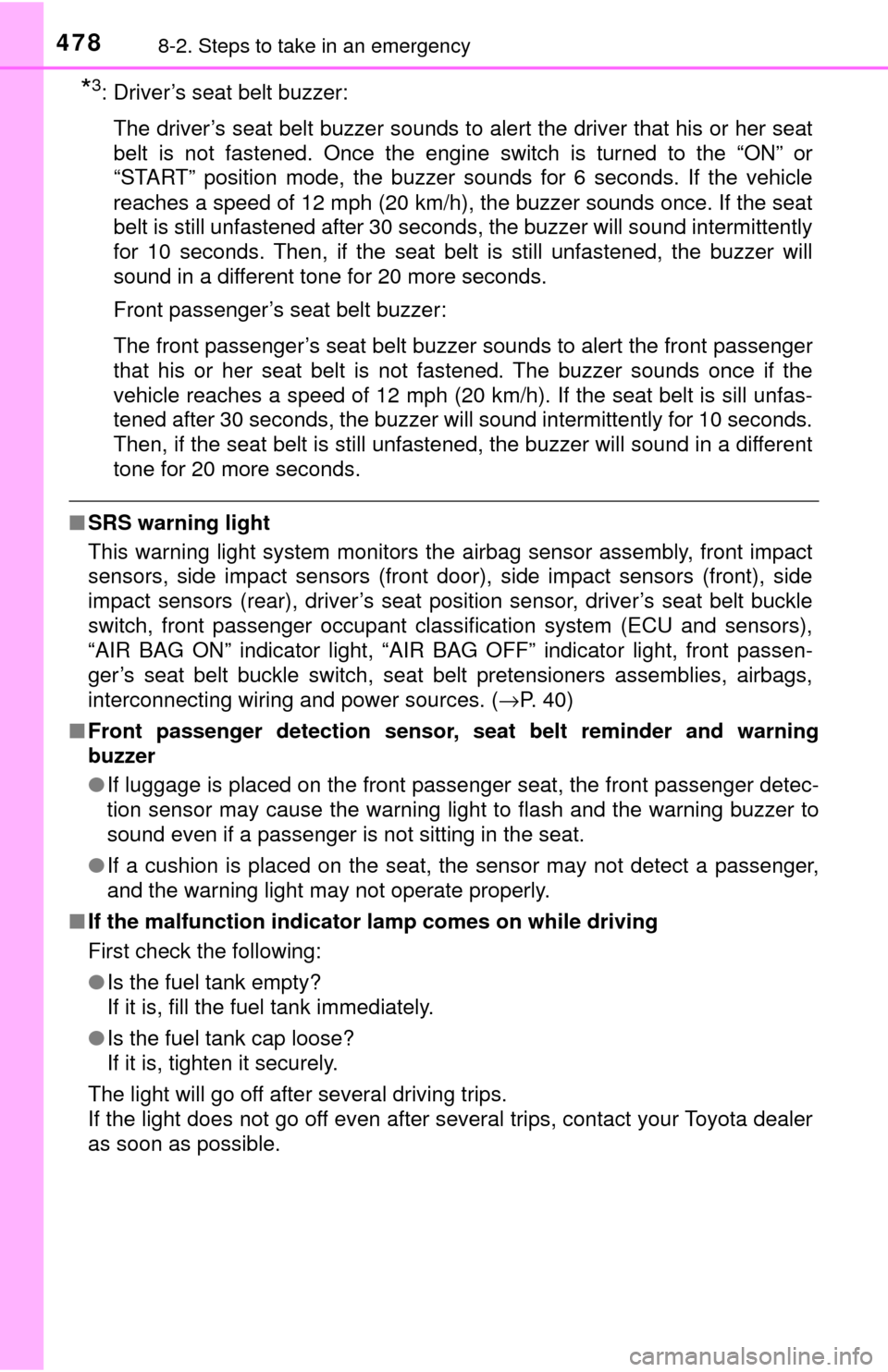
4788-2. Steps to take in an emergency
*3: Driver’s seat belt buzzer:The driver’s seat belt buzzer sounds to alert the driver that his or her seat
belt is not fastened. Once the engine switch is turned to the “ON” or
“START” position mode, the buzzer sounds for 6 seconds. If the vehicle
reaches a speed of 12 mph (20 km/h), the buzzer sounds once. If the seat
belt is still unfastened after 30 seconds, the buzzer will sound intermittently
for 10 seconds. Then, if the seat belt is still unfastened, the buzzer will
sound in a different tone for 20 more seconds.
Front passenger’s seat belt buzzer:
The front passenger’s seat belt buzzer sounds to alert the front passenger
that his or her seat belt is not fastened. The buzzer sounds once if the
vehicle reaches a speed of 12 mph (20 km/h). If the seat belt is sill unfas-
tened after 30 seconds, the buzzer will sound intermittently for 10 seconds.
Then, if the seat belt is still unfastened, the buzzer will sound in a different
tone for 20 more seconds.
■ SRS warning light
This warning light system monitors the airbag sensor assembly, front impact
sensors, side impact sensors (front door), side impact sensors (front), side
impact sensors (rear), driver’s seat posit ion sensor, driver’s seat belt buckle
switch, front passenger occupant classification system (ECU and sensors),
“AIR BAG ON” indicator light, “AIR BAG OFF” indicator light, front passen-
ger’s seat belt buckle switch, seat belt pretensioners assemblies, airbags,
interconnecting wiring and power sources. ( →P. 40)
■ Front passenger detection sensor, seat belt reminder and warning
buzzer
● If luggage is placed on the front passenger seat, the front passenger de\
tec-
tion sensor may cause the warning light to flash and the warning buzzer to
sound even if a passenger is not sitting in the seat.
● If a cushion is placed on the seat, the sensor may not detect a passenger,
and the warning light may not operate properly.
■ If the malfunction indicator la mp comes on while driving
First check the following:
● Is the fuel tank empty?
If it is, fill the fuel tank immediately.
● Is the fuel tank cap loose?
If it is, tighten it securely.
The light will go off after several driving trips.
If the light does not go off even after several trips, contact your Toyota dealer
as soon as possible.
Page 512 of 588
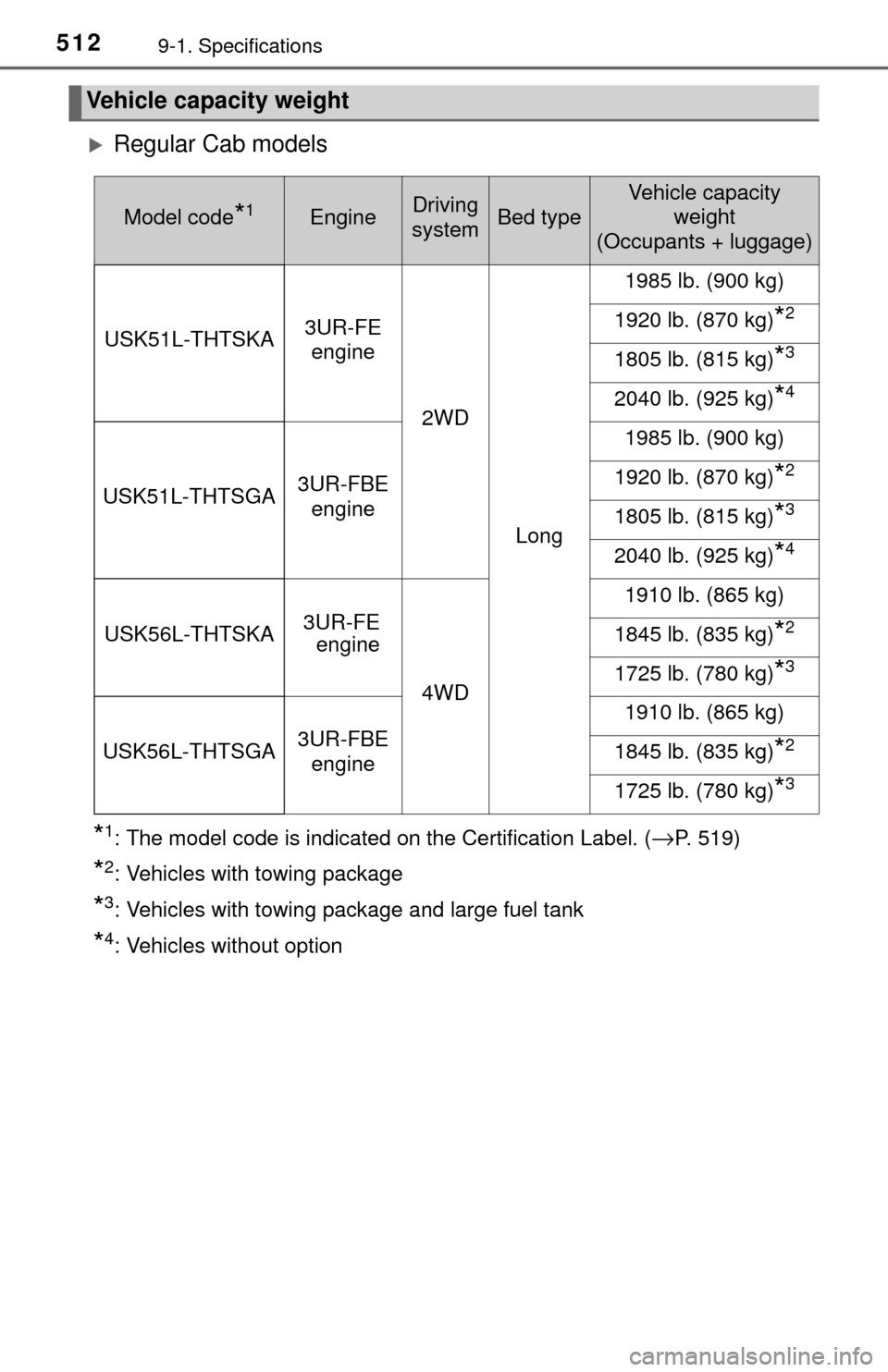
5129-1. Specifications
Regular Cab models
*1: The model code is indicated on the Certification Label. (→P. 519)
*2: Vehicles with towing package
*3: Vehicles with towing package and large fuel tank
*4: Vehicles without option
Vehicle capacity weight
Model code*1EngineDriving
systemBed type
Vehicle capacity weight
(Occupants + luggage)
USK51L-THTSKA 3UR-FE
engine
2WD
Long
1985 lb. (900 kg)
1920 lb. (870 kg)*2
1805 lb. (815 kg)*3
2040 lb. (925 kg)*4
USK51L-THTSGA 3UR-FBE
engine
1985 lb. (900 kg)
1920 lb. (870 kg)*2
1805 lb. (815 kg)*3
2040 lb. (925 kg)*4
USK56L-THTSKA 3UR-FE
engine
4WD
1910 lb. (865 kg)
1845 lb. (835 kg)*2
1725 lb. (780 kg)*3
USK56L-THTSGA 3UR-FBE
engine
1910 lb. (865 kg)
1845 lb. (835 kg)*2
1725 lb. (780 kg)*3